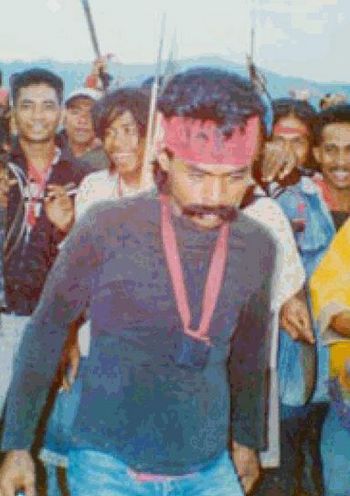Chris Wilson bares the dynamics of conflict behind the violence in North Maluku
Ward Berenschot
Christian militia in TobeloPhoto given to Chris Wilson, 2003 |
Will we ever have an integrated, comprehensive explanation for the bewildering explosions of violence that accompanied the end of the New Order? In a relatively short time span – roughly between 1997 and 2002 – ethnic groups fought each other in Kalimantan, anti-Chinese pogroms took place in (mainly) Java and Sumatra, while Muslims and Christians went after each other in Central Sulawesi, Ambon and North Maluku. This violence was due – at least according to the main studies of this period – to anxieties caused by the destabilisation of established hierarchies and patronage channels during the New Order’s collapse.
Chris Wilson’s study of one such violent region – North Maluku – takes the reader beyond general explanations, and shows how these national developments interacted with local anxieties and power struggles to produce a tragedy from which North Maluku is yet to recover. Based on nine months of fieldwork in different regions of North-Maluku, Wilson discusses how in 1999 and 2000 a relatively small land dispute between ethnic groups gradually morphed into an all-out religious war. In a clear and accessible style, Wilson reconstructs how this relatively minor land dispute in a remote district called Malifut escalated due to the political strategising around the upcoming election of a new governor. When angry victims of this conflict were relocated to Ternate, a chain of reaction and counter-reaction was started that led to more than 3000 deaths, with about 250,000 people displaced.
This violence then spread through North Maluku in different phases. The dispute in Malifut was followed by an anti-Christian pogrom in Ternate and Tidore, which then stimulated Christians in north Halmahera to violently expel the Muslim minority. This was followed, curiously enough, by intra-Muslim fighting in Ternate until the conflict degenerated into a religious war; in the early months of 2000, a ‘jihad army’ of local volunteers were fighting Christian troops in several parts of Halmahera. The violence was the stuff of nightmares: the raging mobs raped, ate hearts, cut off the heads of their victims, and left both churches and mosques full of dead bodies.
Why did this tragedy take place? The ingenuity of Wilson’s book lies in the way the author uses different theoretical perspectives to analyse how the conflict gradually escalated. On each phase he applies a different perspective, familiarising the reader with resource mobilisation theory, instrumentalist theories of violence, theories about identity and the concept of security dilemma. These different perspectives make sense: Wilson shows how the earlier phases can be understood in the light of power struggles between elites, while in the later stages fear of the other side was so intense that, according to Wilson, people engaged in violent pre-emptive attacks to regain a sense of security. It is this application of a broad range of theories of violence that makes Wilson’s book valuable for readers whose interest lies beyond North Maluku or Indonesia: Wilson’s theoretically informed case-study can stimulate thinking on the conflict dynamics behind many other cases of ethnic or religious violence.
It is this application of a broad range of theories of violence that makes Wilson’s book valuable for readers whose interest lies beyond North Maluku or Indonesia
Wilson ends up criticising the general explanation for the post-New Order violence that focuses merely on the collapse of the New Order power struggles. He calls for a ‘syncretic approach’ that focuses not only on the broader structures but also on the motivation of the people on the ground. He wants analysts to pay attention to ‘the interaction of static and changing structures with (…) human agency’: how do social structures cause ordinary people to want violence? That is a promise Wilson does not really fulfill. His book is so focused on describing the violent events themselves, that we get very little information on the social structures in which people in North Maluku live their lives.
And we do not really get to know the violent actors, as Wilson offers very few quotations from his informants about their motivations. What was it about North Maluku that made this province so susceptible to violence? How did the nature of day-to-day life underlie the way people came to accept the use of violence?
As a reader, because I did not get close to the experiences and perceptions of those who perpetrated the violence, I was left with a slightly bewildered feeling. Wilson’s book made me understand the dynamics of the different conflict-phases in North Maluku, but not why people were so easily swayed by these dynamics.
But that is not completely fair to Chris Wilson. One can only do so much in one study: the documentation and analysis of the complex waves of violence must itself have been a gigantic task. By performing it so well he has done a major service to future historians and all those who want to get a better understanding of this dark period in Indonesia’s history.
Chris Wilson, Ethno-Religious Violence in Indonesia: From Soil to God. Oxon: Routledge, 2008.
Ward Berenschot (w.j.berenschot@uva.nl) wrote his PhD thesis on Hindu-Muslim violence in India; he is currently working on a research project that compares India’s and Indonesia’s communal violence.












